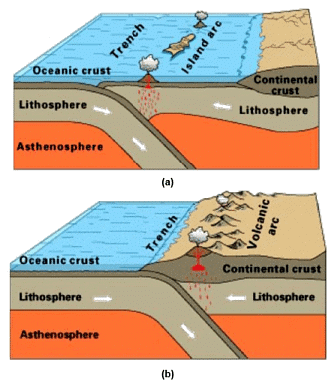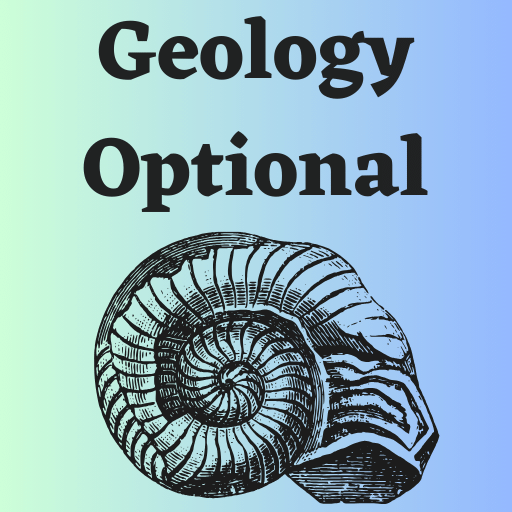Plate Tectonics | Geology Optional Notes for UPSC PDF Download
Introduction
- The theory of plate tectonics posits that the Earth's lithosphere consists of several major and minor plates, which move atop the asthenosphere.
- This theory is widely accepted in geology due to its ability to explain various large-scale geological phenomena and processes.
- Plate tectonics is often referred to as the unifying principle of geology.
Historical Background
- The concept of plate tectonics evolved from the earlier theory of continental drift, which gained traction through multiple developments over several decades.
- Initially, geoscientists viewed the Earth as relatively immobile, with vertical motions such as folding and faulting being predominant.
- Key developments in the early 20th century, such as Mohorovicic's discovery of seismic wave velocity changes and Brunhes' identification of reversed magnetized basalt, laid the groundwork for later theories.
Challenges to Fixist Model
- Wegener's continental drift hypothesis, proposed in the early 20th century, sparked significant interest but faced skepticism regarding its driving forces.
- Support for continental drift resurged in the 1950s, particularly with findings from paleomagnetic studies.
- Discoveries such as negative gravity anomalies near deep-sea trenches and inclined seismic zones beneath oceanic trenches challenged fixist ideas and supported concepts of mantle convection.
Key Discoveries
- Notable discoveries in the late 1950s and early 1960s, including low seismic velocity zones in the mantle and the identification of fracture zones in oceans, provided further evidence for plate tectonics.
- The recognition of different polar wander paths for Europe and North America corroborated the idea of continental movement.
- Important hypotheses such as Vine-Mathews-Morley's proposal of polarity reversals preserved in oceanic crust and Wilson's concept of transform faults further advanced understanding in the field.
Confirmation and Synthesis
- The synthesis of various findings led to the formalization of plate tectonics theory, which explained the rigid-body motion of large plates on Earth's surface.
- The concentration of seismic activity along plate boundaries highlighted the dynamic nature of Earth's tectonics.
- Conferences and collaborative efforts, such as the 1969 global conference organized by William R. Dickinson, helped apply plate tectonics to various aspects of geological study, including continental geology and orogeny.
Lithosphere And Asthenosphere
Lithosphere- The lithosphere, derived from the Greek word "lithos" meaning rocks, constitutes the Earth's outermost layer.
- Comprising the crust (both oceanic and continental) and the rigid upper mantle, the lithosphere sits atop the asthenosphere.
- Physically, the lithosphere is considered strong and rigid, deforming elastically under stress.
- Its thickness varies globally, averaging around 100 km but reaching up to 300 km beneath mountain ranges and less than 50 km beneath oceanic crust.
- The lithosphere consists of distinct segments called lithospheric plates, which are rigid bodies that float and move over the underlying asthenosphere.
Asthenosphere
- The asthenosphere, from the Greek word "asthenes" meaning without strength, is part of the upper mantle lying below the lithosphere.
- Also known as the Low Velocity Zone (LVZ), seismic waves slow down in this region, indicating its semi-fluid nature.
- Located at an average depth of 100 km and extending to depths of 350 to 650 km, the asthenosphere is hot, soft, and semi-viscous.
- It consists of minimal molten material surrounding mineral grains, allowing for the movement of lithospheric plates above it.
- The thickness of the asthenosphere averages between 180 to 220 km, with its upper boundary lying approximately 60 km below oceanic crust and its base reaching depths of up to 700 km.
Internal structure of the Earth showing lithosphere and asthenosphere.

Plates And Their Types
Nature of the Plates
- Lithospheric plates consist of both crust and upper mantle and are controlled by the 1400°C isotherm, representing the temperature of partial melting.
- Oceanic plates are entirely composed of oceanic crust, while continental plates consist entirely of continental crust.
- Continent-oceanic plates are partially composed of oceanic and continental crusts.
- The Earth's lithosphere comprises seven major plates, several minor plates, and numerous micro-plates, collectively forming a mosaic of relatively rigid segments.

Plate Boundary/Plate Margin
- Plate boundary is the surface trace of the zone of motion between two plates, typically several kilometers wide.
- Four types of plate margins exist: constructive (divergent), destructive (convergent), conservative (shear), and plate boundary zone.
- Constructive plate margins involve the continuous upwelling of molten rocks, forming new oceanic crust along mid-oceanic ridges.
- Destructive plate margins feature convergence where one denser plate subducts beneath another, leading to the destruction of the subducting plate in the mantle.
- Conservative plate margins involve plates sliding past each other horizontally along transform faults.
- Plate boundary zones are regions where multiple micro-plates interact between two major plates, contributing to tectonic activity.

This comprehensive understanding of lithosphere, asthenosphere, and plate types lays the foundation for grasping the dynamic processes of plate tectonics and Earth's geological evolution.
Rates of The Plate Movements
- Direct Measurement Methods
- Plate movements are tracked using ground-based or space-based geodetic measurements, with satellite-based methods being most effective due to the global scale of plate motions.
- The Global Positioning System (GPS) is widely used for studying crustal movements by measuring distances between specific points over time.
- Geological Mapping
- Evidence of past plate movements can be inferred from geological mapping of markers, such as rock formations of known ages.
- Comparing the positions of marker rocks across plate boundaries allows estimation of the average rate of plate motion.
- Earth's Magnetic Record
- The ocean floor preserves records of Earth's magnetic normal and reversed polarity events in the form of linear strips.
- By determining the approximate duration of polarity reversals, geologists can calculate the average rate of plate movement over time.
- These rates vary widely, with the slowest rates observed at locations like the Arctic Ridge (less than 2.5 cm/year) and the fastest rates at locations like the East Pacific Rise near Easter Island (more than 15 cm/year).
Mechanisms of The Plate Tectonics
General Theory Assumptions
- The general theory of plate tectonics assumes sea-floor spreading occurs at mid-oceanic ridges, maintaining a constant or slowly changing Earth surface area.
- Once formed, new crust becomes part of a rigid plate, incorporating continental material.
Hypotheses for Plate Movement
- Convection Current Hypothesis: Proposes that convection currents in the mantle cause movement of plates.
- Plates Dragging the Mantle: Suggests that plates, unable to be separated from the asthenosphere, drag the mantle along with their movement.
- Gravity Slide: Argues that Earth's gravity causes plates to slide towards the asthenosphere, generating lateral plate movements.
- Mantle Plumes: States that mantle plumes from the lower mantle or core-mantle boundary create hotspots and drive plate movement radially.
Mantle Plumes
- The mantle plume model, proposed by W.J. Morgan in 1971, suggests rising columns of hot material from the lower mantle feed into the asthenosphere, creating hotspots on the Earth's surface.
- Mantle plumes spread laterally, producing shear stress on the lithosphere's base, resulting in plate divergence along lines of plumes.

Hotspots
- Hotspots are stationary volcanic regions fed by mantle plumes, with eruptions distinct from those at subduction zones or mid-oceanic ridges.
- Hotspots, often located in oceanic regions, provide reference frames for analyzing plate motions and can lead to the formation of aseismic ridges through magma outpouring.

This detailed exploration of plate movement mechanisms and the role of mantle plumes and hotspots contributes to our understanding of Earth's dynamic tectonic processes.
Triple Junctions And Their Present-Day Examples
- The lithosphere consists of interlocking plates, with most tectonic activities occurring along boundaries where two plates interact.
- However, there are regions where three plates converge, forming what is known as a triple junction.
- A triple junction represents the contact region of three plates and can be classified based on the types of plate boundaries involved.
 |
Download the notes
Plate Tectonics
|
Download as PDF |
Types of Triple Junctions
- Ridge-Ridge-Ridge (RRR) Triple Junction: Occurs where three oceanic ridges meet. An example is found in the South Atlantic Ocean, where the ridges of the South American, Antarctic, and African plates converge.
- Trench-Trench-Trench (TTT) Triple Junction: Forms between three oceanic trenches. An example is located in central Japan.
- Ridge-Ridge-Fault (RRF) Triple Junction: Involves two oceanic ridges and one transform fault intersecting.

- Other types include Trench-Trench-Fault (TTF), Trench-Trench-Ridge (TTR), Fault-Fault-Ridge (FFR), Fault-Fault-Trench (FFT), and Ridge-Trench-Fault (RTF) triple junctions.
Stability of Triple Junctions
- The stability of a triple junction depends on various factors, including the geometry of the plates, their relative velocities, and the orientations of the plate boundaries.
- In a stable triple junction, the configuration remains unchanged over time.
- However, in an unstable triple junction, the configuration evolves over time.
- An example of a stable triple junction is the RRR triple junction, while the TTT triple junction represents an unstable configuration.
Understanding the dynamics and stability of triple junctions provides insight into the complex interactions occurring within Earth's lithosphere at convergent points of three tectonic plates.
Present-day examples of triple junctions. R stands for Ridge, F for Fault and T for Trench


Types of Plate Boundaries
Plate tectonics, a fundamental theory in geology, elucidates various geological phenomena such as the formation of mountains, earthquakes, and volcanoes. It offers a comprehensive explanation for the Earth's surface features and movements. According to this theory, the Earth's lithosphere is divided into several large and small plates that float atop the semi-fluid asthenosphere, driving crustal movements.
Lithospheric Plates
- The Earth's lithosphere consists of numerous rigid plates, approximately 100 km thick, that move atop the more ductile asthenosphere.
- These plates are dynamic entities, capable of flexing to some extent, but most deformation occurs along their boundaries.
- Understanding the behavior and interactions of these plates is crucial for comprehending various geological processes.

Classification of Plate Boundaries
Plate movements occur in three primary ways: convergent, divergent, and transform. Each type of boundary is characterized by distinct geological processes and features.
Convergent Plate Boundaries
- Convergent boundaries occur where two lithospheric plates move towards each other.
- When plates collide, one may be forced beneath the other in a process known as subduction, leading to the formation of deep ocean trenches and volcanic arcs.
- These boundaries are associated with intense geological activity, including earthquakes and volcanic eruptions.


Divergent Plate Boundaries
- Divergent boundaries occur where two lithospheric plates move away from each other.
- As the plates separate, magma rises from the mantle to fill the gap, solidifying and creating new crust along mid-ocean ridges or rift valleys on continents.
- Divergent boundaries are characterized by volcanic activity, earthquakes, and the formation of new oceanic crust.

Transform Plate Boundaries
- Transform boundaries occur where two lithospheric plates slide past each other horizontally.
- These boundaries are marked by fault lines, such as the San Andreas Fault in California.
- Transform boundaries can generate powerful earthquakes as friction between the plates is overcome.
Significance of Plate Boundaries
- The majority of geotectonic processes occur at plate boundaries, making them crucial for understanding Earth's geological dynamics.
- Studying plate boundaries provides insights into the distribution of earthquakes, volcanoes, and mountain ranges.
- Understanding the behavior of plate boundaries aids in predicting geological hazards and mitigating their impacts.
In summary, plate boundaries play a pivotal role in shaping the Earth's surface features and driving geological processes. Their classification into convergent, divergent, and transform boundaries helps elucidate the diverse phenomena observed in geology.
FAQs on Plate Tectonics - Geology Optional Notes for UPSC
| 1. What is the difference between the lithosphere and asthenosphere in the context of plate tectonics? |  |
| 2. How many types of plates are present on Earth and what are they? |  |
| 3. What are the rates of plate movements on Earth? |  |
| 4. What are the mechanisms responsible for plate tectonics? |  |
| 5. Can you provide examples of present-day triple junctions and their significance in plate tectonics? |  |

































